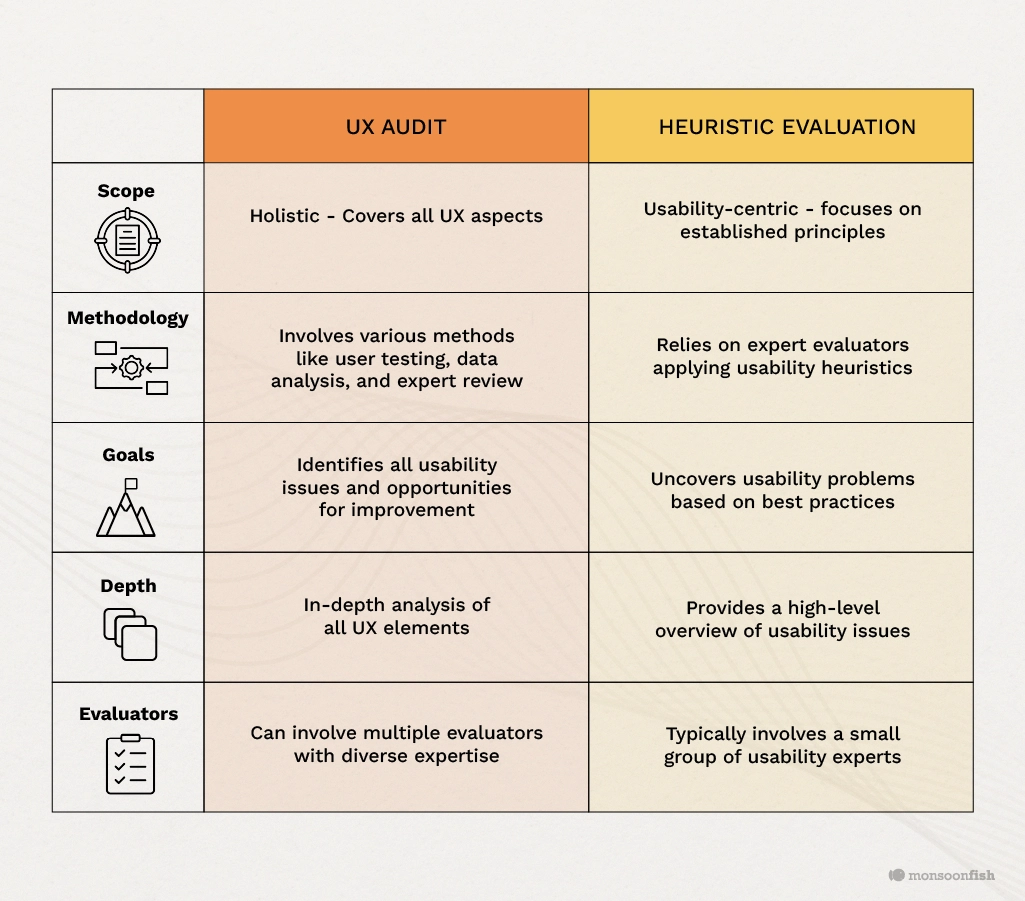UX Audit vs Heuristic Evaluation: Are they the Same?
While heuristic evaluations provide focused insights into usability issues based on recognized principles, UX audits offer a broader examination, considering additional factors such as accessibility and visual design.

CONTENTS
What’s the Difference between a UX Audit & Heuristic Evaluation?What is a UX Audit?What is a Heuristic Evaluation?UX Audit vs Heuristic Evaluation: Scope & DepthUX Audit vs Heuristic Evaluation: Evaluators & ExpertiseComparing the Output, Reporting & RecommendationsWhich One is More Comprehensive?Social Share
Have you ever wondered which method will help you identify that how and why a whopping 88% of online consumers are less likely to return to a website after a bad user experience – UX audit or Heuristic evaluation? As a product owner, you might hear UX designers discuss “UX Audit” and “Heuristic Evaluation” and wonder if they’re the same. Understanding these two fundamental practices can empower you to make informed decisions for ensuring a seamless user experience to your users.
While both aim to improve your product, there are differences to be aware of.
A UX Audit is a broad examination, like a full check-up for your product. It uses various tools, including a heuristic evaluation (where experts assess usability based on best practices), but might also involve user testing, data analysis, and interviews to uncover deeper issues.
A heuristic evaluation, on the other hand, is more focused – a specialist reviews your product against usability principles. So, while a heuristic evaluation is a valuable tool, a UX Audit provides a more comprehensive picture of your product’s user experience.
Let’s delve deeper and understand how these practices can elevate your user experience!
What’s the Difference between a UX Audit & Heuristic Evaluation?
A UX audit involves a comprehensive inspection of your product’s usability and user experience, typically conducted by a specialist to identify usability issues. On the other hand, a heuristic evaluation is a method used to pinpoint design problems in user interfaces by experienced audit experts who assess a platform based on a set of guidelines known as heuristics. While a UX audit provides a detailed examination of your system to uncover usability problems, heuristic evaluation focuses on identifying design issues quickly and effectively by evaluating against established usability principles. Both methods play crucial roles in enhancing the overall user experience of your product, with a UX audit offering a broader usability assessment and heuristic evaluation providing a more focused and rapid evaluation of design aspects.

What is a UX Audit?
A UX audit involves an expert evaluation of your product’s usability and user experience, analyzing existing user journeys to identify actionable areas for improvement.
For enterprise products, a UX audit can yield significant benefits, as it relies on data rather than assumptions.
A UX Audit Evaluates various UX elements:
- Usability: How easy and intuitive is it to use the product?
- Accessibility: Can users with disabilities interact with the product effectively?
- Visual Design: Does the product have a visually appealing and user-friendly interface?
- Information Architecture: Is the content organized logically and easy to find?
What is a Heuristic Evaluation?
Heuristic Evaluation is like a detailed checkup for your product’s usability. Instead of just pointing out problems, a usability expert or a small group looks at your product and checks if it follows certain usability rules, like the famous 10 rules from Nielsen Norman Group. Usability experts go through the features and screens of your product to see if it matches up with these rules.
A good heuristic evaluation gives a clear idea of how good the user experience is. It’s important because you can measure it. By giving scores to each rule, you can see how your product can improve over time. Instead of just listing problems, it’s more like a scorecard that shows which areas of your product need the most attention.
UX Audit vs Heuristic Evaluation: Scope & Depth
Heuristic evaluations can be conducted on either specific sections of a product or the product/website as a whole. The extent of the evaluation is decided by considering the evaluation objectives and available resources.
A UX audit on the other hand usually encompasses a thorough assessment of the entire product/website. It evaluates various facets of the user experience, striving to offer a comprehensive overview of the application’s strengths and weaknesses.
UX Audit vs Heuristic Evaluation: Evaluators & Expertise
In a UX audit there is collaboration among a diverse team of professionals with expertise in UX research, design, and information architecture. This multidisciplinary approach ensures comprehensive coverage and analysis of various aspects of your product’s user experience.
Whereas heuristic evaluations predominantly rely on usability experts who possess specialized skills in identifying and assessing usability issues based on established principles or heuristics. These experts navigate through your product or website features and screens, evaluating them against recognized usability guidelines to pinpoint areas for improvement.
While both methods contribute valuable insights, the collaborative nature of a UX audit offers a broader perspective, while heuristic evaluations provide targeted assessments by specialists in usability.
Comparing the Output, Reporting & Recommendations
The output, reporting, and recommendations of UX audits and heuristic evaluations differ in their scope and specificity. In a UX audit, the deliverable typically consists of a comprehensive report detailing identified issues across various UX elements. This report includes not only the issues themselves but also their severity and the potential impact on the user experience. Furthermore, UX audits offer actionable recommendations for your product’s improvement that span a wide range of factors, including usability, accessibility, information architecture, and visual design.
In contrast, heuristic evaluations provide a more focused report primarily centered on just the usability issues. While they offer recommendations for addressing these specific issues, the scope of the report is narrower compared to UX audits.
Which One is More Comprehensive?
In terms of comprehensiveness, a UX audit stands out for its thorough examination, offering a comprehensive understanding of the user experience across various dimensions. It delves deep into usability, visual design, information architecture, interaction design, responsiveness, accessibility, and performance of your product. This broader perspective allows for a nuanced analysis, uncovering potential issues that may otherwise go unnoticed.
A UX audit holds particular advantages for projects needing a complete revamp of the user experience or those in their nascent development phases. However, it’s important to note that a UX audit can be conducted at any stage of the product lifecycle. It’s not limited to just complete overhauls; it can also be beneficial for assessing and improving specific user-flows or user-journeys within the product.
Its comprehensive nature makes it well-suited to identify fundamental areas for improvement and guide strategic decisions from the outset. Conversely, heuristic evaluations are better suited for pinpointing specific usability concerns in existing products or during later stages of development, providing focused insights to address immediate issues and refine the user experience iteratively.
Looking for a Customized UX Audit for Your Product?
Now that you comprehend the unique roles of UX audits and heuristic evaluations in the design journey, it’s evident that a UX audit offers invaluable insights for optimizing the value and effectiveness of your digital products. Here at Monsoonfish, we offer customized UX audit services to suit your unique needs ensuring the development of user experiences that foster engagement and success.
Ready to discuss your project? Reach out to our team today!





